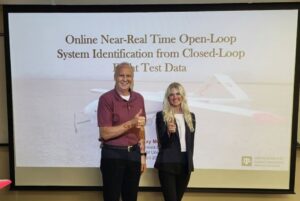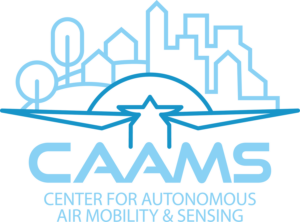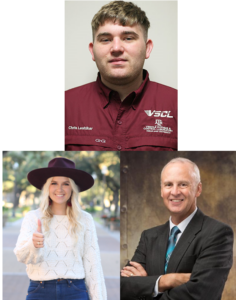Cassie-Kay McQuinn (B.S. Aerospace Engineering, TAMU) successfully defended her Masters thesis titled “Online Near-Real Time Open-Loop System Identification from Closed-Loop Flight Test Data“.

Cassie-Kay’s thesis investigated identifying linear dynamic models onboard a vehicle in near-real time with and without an active controller. This is performed for a small Unmanned Air System (UAS) utilizing low cost, commercial-off-the-shelf components. Bare airframe longitudinal, lateral/directional and combined longitudinal lateral/directional models of the test vehicle are generated both onboard the vehicle during flight and offline during post-processing. The Developmental Flight Test Instrumentation 2 (DFTI2), utilizing the Robot Operating System (ROS), is extended to compute system models onboard the vehicle from both open-loop and closed-loop data. Additionally, a controller is implemented into the system, external to the primary flight controller, to generate and record controller inputs for the closed-loop system. The Observer/Kalman filter Identification (OKID) algorithm is used to generate locally linear models of the flight vehicle. Models are generated independent of actuator dynamics by mapping deflection angle to measured servo potentiometer readings. Orthogonal Schroeder sine sweep excitations are utilized to reduce potential control coupling while also exciting multiple frequencies. Identified models are presented and evaluated. Offline analysis of closed-loop flight data provides insight into the controller utilized in flight. Results presented in the thesis show the extended system can generate models suitable for describing the dynamics of the vehicle operating both with and without a controller implemented.
This work is sponsored by the National Science Foundation (NSF) Center for Autonomous Air Mobility and Sensing (CAAMS). Conference and journal papers are being written on this work. Cassie-Kay’s is the 60th graduate degree earned by a VSCL graduate student.


 This paper presents a summary of system identification flight testing and results for a variety of large and small fixed-wing and multirotor Unmanned Air Systems at Texas A&M University from 1999-2023. The six different types of vehicles range from a large powered-parafoil, to a fixed-wing vehicle with synthetic jet actuated roll control effectors, to a radially asymmetric multirotor, to large and small fixed-wing vehicles, and a Steppe eagle. The Observer/Kalman Filter Identification algorithm is used to generate linear time invariant state-space models, and results for both near real-time online model generation, and post-flight offline model generation are presented. The use and efficacy of a variety of test input types and their sensitivity to exogenous inputs such as turbulence, in addition to identified model evaluation and selection criteria are discussed. Several generations of low size, weight, power, and cost flight test instrumentation including the Developmental Flight Test Instrumentation data acquisition package are also presented. Challenges that arose from the flight testing campaigns along with solutions are highlighted in the paper.
This paper presents a summary of system identification flight testing and results for a variety of large and small fixed-wing and multirotor Unmanned Air Systems at Texas A&M University from 1999-2023. The six different types of vehicles range from a large powered-parafoil, to a fixed-wing vehicle with synthetic jet actuated roll control effectors, to a radially asymmetric multirotor, to large and small fixed-wing vehicles, and a Steppe eagle. The Observer/Kalman Filter Identification algorithm is used to generate linear time invariant state-space models, and results for both near real-time online model generation, and post-flight offline model generation are presented. The use and efficacy of a variety of test input types and their sensitivity to exogenous inputs such as turbulence, in addition to identified model evaluation and selection criteria are discussed. Several generations of low size, weight, power, and cost flight test instrumentation including the Developmental Flight Test Instrumentation data acquisition package are also presented. Challenges that arose from the flight testing campaigns along with solutions are highlighted in the paper.